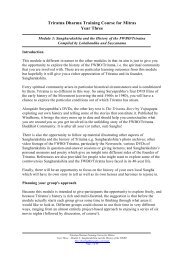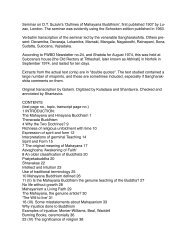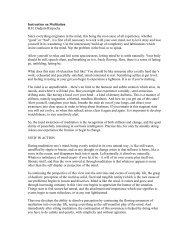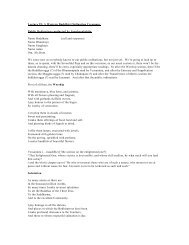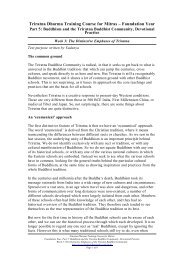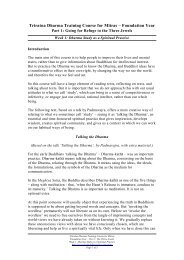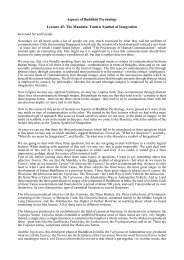Buddhism and Quantum Physics - Free Buddhist Audio
Buddhism and Quantum Physics - Free Buddhist Audio
Buddhism and Quantum Physics - Free Buddhist Audio
Create successful ePaper yourself
Turn your PDF publications into a flip-book with our unique Google optimized e-Paper software.
concept of reality but to a calamitous separation between philosophy <strong>and</strong> the modernphysical sciences. It has served only to sharpen that dualism that preoccupies modernthought. According to the physicist P.C.W. Davies electrons, photons or atoms do notexist, they are nothing but models of thought. (See: P.C.W. Davies, ‘The Ghost in theAtom’, Cambridge 1986.)HolismThe view that an organic or integrated whole has a reality independent of <strong>and</strong> greater thanthe sum of its parts [Webster's Dictionary, New York 1968]. This third approach tries toavoid the calamitous either-or-scheme of the first two approaches by fusing subject <strong>and</strong>object into one whole, such that there are no longer any parts but only one identity: all isone. That whole is made absolute <strong>and</strong> is mystified. It becomes an independent unity thatexists without dependence on its parts. Wholeness is understood as something concrete,as if it were an object of experience. As a philosophical approach found in great periodsof European history of philosophy, this view is connected with names like ThomasAquinas, Leibniz, Schelling. In quantum physics holism is represented by David Bohm[4].InstrumentalismThe fourth approach consists in refuting or ignoring the existence of subject <strong>and</strong> object.Instead of favouring einther one or the other or the two together, this metaphysicalapproach refutes them both. The search for reality is according to this viewpointinsignificant or meaningless. Instrumentalism is very modern, intelligent [for example inthe person of Ernst Cassirer], <strong>and</strong> sometimes somewhat captious. It is difficult todisengage from it. As an extension of subjectivism it consists of regarding thinking asthinking in models, which is regarded as a working with information without concern asto what phenomena the information is about. It inherits this problem from subjectivism,about which the philosopher Donald Davidson wrote: “Once one makes the decision forthe Cartesian approach, it seems that one is unable to indicate what ones proofs areevidence for”[5]. Instrumentalism is a collective term that denotes a variety of scientificapproaches. They have the common feature of considering the totality of humanknowledge, including scientific constructs, statements <strong>and</strong> theories, as not at all orsometimes merely not primarily, realistic reproductions of the structure of reality. Ratherit considers them to be the result of human's interactions with nature for the purpose ofestablishing theoretically <strong>and</strong> practically successful models. For instrumentalism theoriesare not a description of the world but are an instrument for a systematic classification <strong>and</strong>explanation of observations <strong>and</strong> for the predictions of facts. The instrumentalist approachis outlined by the experimental physicist Anton Zeilinger. Zeilinger stated in aninterview: “In classical physics we speak of a world of things that exists somewhereoutside <strong>and</strong> we describe their nature. In quantum physics we have learned that we have tobe very careful about this. Ultimately physical sciences are not sciences of nature butsciences of statements about nature. Nature in itself is always a construction of mind.Niels Bohr once put it like this: There is no world of quantum, there is only a quantummechanical desciption”[6].
Nagarjuna presents these four extreme concepts of reality in a scheme that is called inSanskrit: catuskoti <strong>and</strong> in Greek: tetralemma. In a short form they can be expressed asfollows:Things do not arise substantially: 1. either out of themselves, 2. nor out of somethingelse, 3. nor out of both, 4. nor without a cause.Behind this scheme there are, as metioned before, four concepts of reality that can berelated to substantial, subjective, holistic <strong>and</strong> instrumentalist modes of thought in themodern world. It would be difficult to find a modern person who does not, in his ownway, hold one of these four extreme views. This shows that Nagarjuna's philosophy isvery up-to-date. Nagarjuna did not refute 1. the substantial modes of thought in oder toend up in 2. subjectivism, even though this is often claimed against him. Nor did herefute the either or mode of thought in order to end with a view of 3. holism, identity, orwholeness, which some benevolent interpreters say of him. Nor did he refute holism inorder to end up at 4. instrumentalism, as is believed by many modern interpreters inimitation of the philosopher Ludwig Wittgenstein. Nagarjuna does not fall into any ofthese extremes because these are the exact four extreme metaphysical concepts that hesystematically refutes.Already in the very first verse of the MMK, he points out not only the dilemma but thewhole tetralemma of our thinking. That verse states: “Neither from itself nor fromanother, nor from both, nor without a cause does anything whatever anyeherearises”[Garfield's translation]. This verse can be understood as the principal statement ofthe Mulamadhyamaka-karika [MMK]: The refutation of the four extreme metaphysicalviews, that cannot be reconciled with the dependent arising of things. If this is the case,the remainder of the MMK would be merely a clarification of this first verse. Thereforethis requires careful examination. What is the assertion made by this verse? That nothingcan be found, that there is nothing, that nothing exists? Was Nagarjuna denying theexternal world? Did he wish to refute that which evidently is? Did he want to call intoquestion the world in which we live? Did he wish to deny the presence everyehere ofthings that somehow arise? If by 'arise' we underst<strong>and</strong> the notion of the empirical arisingof things then we are obliged to argue that if a thing does not arise out of itself, it mustarise out of something else. So we should ask: what is the significance of the concept 'toarise'?In another text, Nagarjuna himself gives some indication of how to underst<strong>and</strong> thisconcept. He writes in his work Yuktisastika [YS]: “19. That which has arisendependently on this <strong>and</strong> that that has not arisen substantially [svabhavatah]. What has notarisen substantially, how can it literally [nama] be called 'arisen'?.” “That whichoriginates due to a cause <strong>and</strong> does not abide without [certain] conditions but disappearswhen the conditions are absent, how can it be understood as 'to exist'”? [7]. By theconcepts of 'arising' <strong>and</strong> 'exist' Nagarjuna does not mean the empirical but the substantialarising or existence. When in many other passages of Mulamadhyamaka-karikaNagarjuna states that things do not arise [MMK 7.29], that they do not exist [MMK 3.7,
tradition when he wrote: “For the classification of things that are introduced in physics, itis essential that these things have for a certain time an independent existence, in so far asthese things lie 'in different parts of space'. Without the assumption of such anindependent existence [So-sein, suchness] of things which, in terms of ordinary thoughtare spatially distant from each other, physical thought in the usual sense would not bepossible”[10].This idea of an independent reality was projected on to the basic element of the world ofmatter by atomism. For atomism, a scientific explanation means to reduce the variability<strong>and</strong> variety of objects <strong>and</strong> conditions to their permanent, stable, independent, indivisibleelements or to their conformity with mathematical laws. According to the expectations ofatomism all variations in nature can be explained in terms of separation, association <strong>and</strong>movements of unchanging, independent atoms or still more elementary particles. Theseparticles <strong>and</strong> their conformity to mathematical laws constitute the core of things, underlieeverything <strong>and</strong> hold the world together. The question whether the fundamental objectsare waves or particles, was an explosive issue: at stake were the traditional metaphysicalconcepts of reality available to quantum physics. It became evident that the fundamentalreality could not be grasped by traditional concepts of reality. What is the explanatoryworth of atomism if it become clear that there are no independent, stable atoms orelementary particles <strong>and</strong> that objects have no stable core? Were these quantum objectsobjective, subjective, both or neither? What is reality? Is the quantum world distinct fromthe world in which we are living?Niels BohrIn 1927, the physicist Niels Bohr introduced the concept of complementarity intoquantum physics. According to this concept the wave form <strong>and</strong> the particle form are nottwo separate forms that contradict <strong>and</strong> exclude each other but are mutuallycomplementary forms that only together can provide a complete description of physicalmanifestations. According to Niels Bohr, complementarity meant that in the quantumworld it is impossible to speak about independent quantum objects because they are in aninteractive relashionship with each other, as well as with the instrument if measurement.Niels Bohr emphasised that this interaction between the quantum object <strong>and</strong> theinstrument of measurement was an inseparable element of quantum objects, because itplays a major part in the development of several features of quantum objects. Certainmeasurements establish electrons or photons as particles <strong>and</strong> destroy the interference thatdistinguishes the object as a wave. Other measurements establish the object as a wave.This was Niels Bohr's new concept of reality. From the insight that the quantum object<strong>and</strong> the instrument of measurement could not be separated, Niels Bohr did not concludethat there are no quantum objects. At least he did not do so when he was arguing in termsof physics. When he spoke about the metaphysics of quantum physics he sometimes tookan instrumentalist approach [11]. For Niels Bohr the fundamental physical reality consistsof interacting <strong>and</strong> complementary quantum objects.
Interaction in the st<strong>and</strong>ard model of quantum physicsIn the meantime the concept of the four interactions was introduced into the st<strong>and</strong>ardmodel of quantum physics. These four elementary interactions or four forces obstruct thereduction of quantum objects into independent objects – as Democritus had suggested.The interactions, the forces that operate between the quantum objects, are added to thequantum objects. Instead of singular, independent objects two-body-systems or manybody-systemswere established as the base of matter. Between the bodies interactingforces are effective in keeping the bodies together [12]. These interactions are acomposite of the bodies. Mostly they are forces of attraction <strong>and</strong> in the case of electromagneticforces they can also be forces of repulsion. One visualises the interactionbetween the elementary particles as an interchange of elementary particles. The physicistSteven Weinberg writes about this: At the present moment the closest we can come to aunified view of nature is a description in terms of elemntary particles <strong>and</strong> their mutualinteractions [...] The most familiar are gravitation <strong>and</strong> electromagnetism, which, becauseof their long range, are experienced in the everyday world. Gravity holds our feet on theground <strong>and</strong> the planets in their orbits. Electromagnetic interactions of electrons <strong>and</strong>atomic nuclei are responsible for all the familiar chemical <strong>and</strong> physical properties ofordinary solids, liquids <strong>and</strong> gases. Next, both in range <strong>and</strong> familiarity, are the 'strong'interactions, which hold protons <strong>and</strong> neutrons together in the atomic nucleus. The strongforces are limited in range to about 10 -13 centimeter <strong>and</strong> so are quite insignificant inordinary life, or even in the scale (10 -8 centimeter) of the atom. Least familiar are the'weak' interactions. They are of such short range (less than 10 -15 centimeter) <strong>and</strong> are soweak that they do not seem to play a rôle in holding anything together” [13].In this respect the explanations enter into very difficult <strong>and</strong> subtle particulars. How forexample, can an electron which consists only of one particle have an interaction withanother quantum object? What part of itself can it emit if it consists only of one particle?This question can be answered by the concept of interactions. In fact an electron does notexist of only a single particle exactly because the interaction of the electron is a part of it.In an article from 1978 about super-gravitation the two physicists Daniel Z. <strong>Free</strong>dman<strong>and</strong> Pieter von Nieuwenhuizen wrote about it as follows: “The observed electron mass isthe sum of the 'bare mass' <strong>and</strong> the 'self-energy' resulting from the interaction of theelectron with its own electromagnetic field. Only the sum of the two terms isobservable”[14].What quantum physics knows about interactions is here summarised in the words of thephysicist Gerhard 't Hooft who writes: “An electron is surrounded by a cloud of virtualparticles, which it continually emits <strong>and</strong> absorbs. This cloud does not consist of photonsonly, but also of pairs of charged particles, for example electrons <strong>and</strong> their anti-particles,the positrons”[...] “Even a quark is surrounded by a cloud of gluons <strong>and</strong> pairs of quark<strong>and</strong> anti-quark” [15].Singular, isolated, independent quarks have never been observed. In the new research thisphenomenon is called 'confinement'. This means quarks are captives, they cannot appearas a single quark but only as one of a pair or as one of a trio. When you try to separatetwo quarks by force, there will appear new quarks between them, that combine into pairs
<strong>and</strong> trios. Claudio Rebbi <strong>and</strong> other physicists have reportet: “Between the quarks <strong>and</strong>gluons inside an elementary particle, additional quarks <strong>and</strong> gluons are continously formed<strong>and</strong> after a short time again subside” [16]. These clouds of virtual particles represent orproduce interactions.We now arrived at the central core of quantum physics. It consists of a new concept ofreality, that no longer perceives singular, independent elements as the fundamental unit ofreality but rather two-body-systems or two states of a quantum object or two conceptssuch as earth & moon, proton & electron, proton & neutron, quark & anti-quark, wave &measuring instrument, particle & measuring instrument, twin photons, superpositions,spin up & spin down, matter & anti-matter, elementary particle & field of force, low ofnature & matter, symmetry & anti-symmetry etc These systems cannot be separated intoindependent parts. They cannot be reduced to two separate, independent bodies or states,nor is one fudamental <strong>and</strong> the other derived as the metaphysical either-or-scheme ofsubstantialism or subjectivism usually try to establish. Nor are they joined into a seamlessunity, they are not the same, they are not identical, they are not a mysterious wholenessas holism indicates. Nor can one claim that they are nothing but mathematical modelsthat we have constructed <strong>and</strong> that do not correspond to physical reality, asinstrumentalism claims.In physics there is a fundamental reality that is not a one-body-system but a two-bodysystemor an assembly of bodies, a claud of virtual particles, which surround the centralor the 'naked' body. Between these bodies there is an interaction that is one of thecomposite of these bodies. This underst<strong>and</strong>ing of physics cannot be disloged <strong>and</strong> yet allour metaphysical schemata struggle against it. This cloud does not conform to ourtraditional metaphysical expectations of that which should delineate <strong>and</strong> underpinstability, substantiality <strong>and</strong> order. How can clouds be what we are used to calling thebasic elements of matter? How can this small vibrating something be what generations ofphilosophers <strong>and</strong> phsicists have been searching for in oder to arrive at the core of matteror at the ultimate reality? Is this supposed to be it? From these little clouds we attempt touse metaphysical interpretation to distil something that has substance <strong>and</strong> that endures.Entirely within the sense of the substance metaphysics of Plato, Werner Heisenberg saidthat the mathematical forms are the idea of elementary particles <strong>and</strong> that the object ofelementary particles is corresponding to this mathematical idea. Carl Friedrich vonWeizsäcker called mathematics 'the essence of nature'. According to the physicist HerwigSchopper, fields of force are the ultimate reality [17]. Some of us want to see reality as amysterous whole [holism], or dismiss them as a construction without any correspondenceto empirical reality [instrumentalism]. All of this only because we do not find it easy toadmit that the complex interactions of the world in which we live , have their roots in areality that is itself a complex reality. It is impossible to escape from the entanglement ofthis world by quantum physics. It is impossible to find an elementary quantum object thatis not dependent on other quantum objects or dependent on parts of itself. It is impossibleto dissolve the double-sided character of quantum objects. The fundamental reality of ourphysical world consists of clouds of interacting quantum objects.
ResultsReality is not static, solid or independent. It does not consist of singular, isolated materialor immaterial factors, but of systems of dependent bodies. [I use the expression 'body'synonymously like 'quantum object' or 'particle' or 'field' or 'system' or 'entity'. There isjust a small difference between these expressions that can be neglected]. Mostly thesystems consist of more than two components, but there are no systems that consist ofless that two components. In quantum physics we call such fudamental two-body-systemsearth & moon, electron & positron, quark & anti-quark, elementary particle & field offorce. Nagarjuna calls his systems or dependent pairs walking person & way to bewalked, fire & fuel, agent & action, seer & object of seeing. Both of these modelsdescribe two-body-systems or two entities which have bodies that are neither properlyseparate, nor properly joined together. They do not fall into one, nor do they fall apart.These bodies are not independent <strong>and</strong> they cannot be observed singly because in theirvery existence <strong>and</strong> constitution they are dependent on each other <strong>and</strong> cannot exist orfunction independently of each other. They are entangled by interactions, even in a fardistance. One of them cannot be reduced to the other; it is not possible to explain one ofthem on the basis of the other. The resultant systems have a fragile stability, thecomponents of which are maintained by interactions <strong>and</strong> mutual dependencies that aresometimes known, sometimes not fully known <strong>and</strong> sometimes as with entangled twinphotons for example, totally unknown.What is reality?We have become accustomed to firm ground beneath our feet <strong>and</strong> fleeting clouds in thesky. The concept of reality of Nagarjuna's philosophy <strong>and</strong> the concepts ofcomplementarity <strong>and</strong> interactions of quantum physics teach us something quite differentthat one could express metaphorically as: everything is build on s<strong>and</strong> <strong>and</strong> not even thegrains of s<strong>and</strong> have a solid core or nucleus. There stability is based on the unstableinteractions of their component parts.Notes1. See: Etienne Lamotte, Traité de la Gr<strong>and</strong>e Vertu de Sagesse de Nagarjuna, Tome I-V,Louvain 1944 ff, Tome III, p. IX2. See: Chr. Lindtner, Nagarjuniana, Copenhagen 19823. See: David J. Kalupahana, Nagarjuna. The Philosophy of the Middle Way, New York1986. See: Jay L. Garfield [ed.], The Fundamental Wisdom of the Madhyamakakarika,Oxford 19954. See: David Bohm, Die implizite Ordnung, München 1985, S. 200. David Bohm,Wholeness <strong>and</strong> the Implicate Order (Routledge Classics) London 2000. Bohm's key wordis 'holomovement', an 'undivided wholeness in flowing movement'.
5. Donald Davidson, Der Mythos des Subjektiven, Stuttgart 1993, p. 90. English: TheMyth of the Subjective6. Anton Zeilinger, Interview at the german newspaper 'Tagesspiegel', December 20 th ,1999. Steven Hawkings is defending a very similar position. He says: “I, on the otherh<strong>and</strong>, am a positivist who believes that physical theories are just mathematical models weconstruct, <strong>and</strong> that it is meaningless to ask if they correspond to reality, just whether theypredict observations”, Stephen Hawkings, in: Roger Penrose. The Large, the Small <strong>and</strong>the Human Mind, Cambridge 2000, p.169. It is not meaningless to ask about thecorrespondence between a model & object, because if a model is correct then it hasstructural similarities with the phenomena that it is reconstructing, otherwise it can leadto predictions for which there are no meaningful physical explanation, because they haveno correspondence to experimental data. See also: B.C.v. Fraassen, The Scientific Image,Oxford 1980 <strong>and</strong> B.C.v. Fraassen, Laws <strong>and</strong> Symmetry, Oxford 19897. See: Chr. Lindtner, op.cit., p. 109, 1138. Tarab Tulku Rinpoche, UD-Newsletter N. 4, January 2006. See: Geshe Rabten,Mahamudra, Le Mont Pélèrin 2002, p. 255. See: Damien Keown, A Dictionary of<strong>Buddhism</strong>, Oxford University Press 20039. See: Irvin Rock, Wahrnehmung: vom visuellen Reiz zum Sehen und Erkennen,Heidelberg, Berlin 1988. See: Irvin Rock, Perception, New York 198410. Albert Einstein, Quantenmechanik und Wirklichkeit, 'Dialectica 2', 1948, p.320-32411. Niels Bohr, Collected Works, Volume 6, North-Holl<strong>and</strong>, Amsterdam, New York,Oxford, Tokyo 1985, p. 103: “I do not know what quantum mechanic is. I think we aredealing with some mathematical methods which are adequate for description of ourexperiments”[1927].12. “The most convenient context for investigating the forces of nature is a system of twoobjects bound together by mutual attraction. The earth <strong>and</strong> the moon, for example,constitute the most readyly accessible system in which to observe the gravitational force.The hydrogen atom, consisting of an electron <strong>and</strong> a proton, has long been an essentialtesting ground for theories of the electromagnetic force. The deuterion, made up of aproton <strong>and</strong> a neutron, represents a model system for studies of the forces in the atomicnucleus. Now there is a bound system in which to investigate the force that acts betweenquarks, the constituents of protons, neutrons <strong>and</strong> many related particles. The system iscalled quarkonium, <strong>and</strong> it consists of a heavy quark bound to an equally massivantiquark. The force at work in quarkonium is the strongest one known; it has come to becalled the color force, <strong>and</strong> it is now thought to be the basis of all nuclear forces. Of thevarious two-body systems the simplest in some respects is the artificial atom calledpositronium”[ Elliot D. Bloom/Gary J. Feldman, Quarkonium, Scientific American, May1982, Volume 246, Number 5, p. 42]
13. Steven Weinberg, Unified Theories of Elementary-Particle Interaction, ScientificAmerican, July 1974, Volume 231, Number 1, p. 5014. Daniel Z. Friedman/Peter Niuwenhuizen, Supergravity <strong>and</strong> the Unification of theLaws of <strong>Physics</strong>, Scientific American, February 1978, Volume 238, Number 2, p. 13215. Gerhard 't Hooft, Symmetrien in der Physik der Elementarteilchen, in: Teilchen,Felder und Symmetrien, Spektrum, Heidelberg 1995, p. 42, 4616. Claudio Rebbi, quoted in: Frankfurter Allgemeine Zeitung, September 5 th , 200117. See: Werner Heisenberg, Gesammelte Werke, B<strong>and</strong> III, München 1985, p. 326. See:Werner Heisenberg, Der Teil und das Ganze, München 1969, p.141 f. See: Carl Friedrichvon Weizsäcker, Ein Blick auf Platon, Stuttgart 1988, p. 134. See: Herwig Schopper,'Frankfurter Allgemeine Zeitung', May 5 th , 1999Christian Thomas Kohl: http://ctkohl.googlepages.com/Swiss Biennial on Science, Technics <strong>and</strong> Aesthetics:http://www.neugalu.ch/e_bienn_2007.htmlThis is a preprint of an article submitted for consideration in the 'Contemporary<strong>Buddhism</strong>', N° 8, 2007 [[copyright Taylor & Francis]; 'Contemporary <strong>Buddhism</strong>' isavailable online at: http://journalsonline.t<strong>and</strong>f.co.uk



